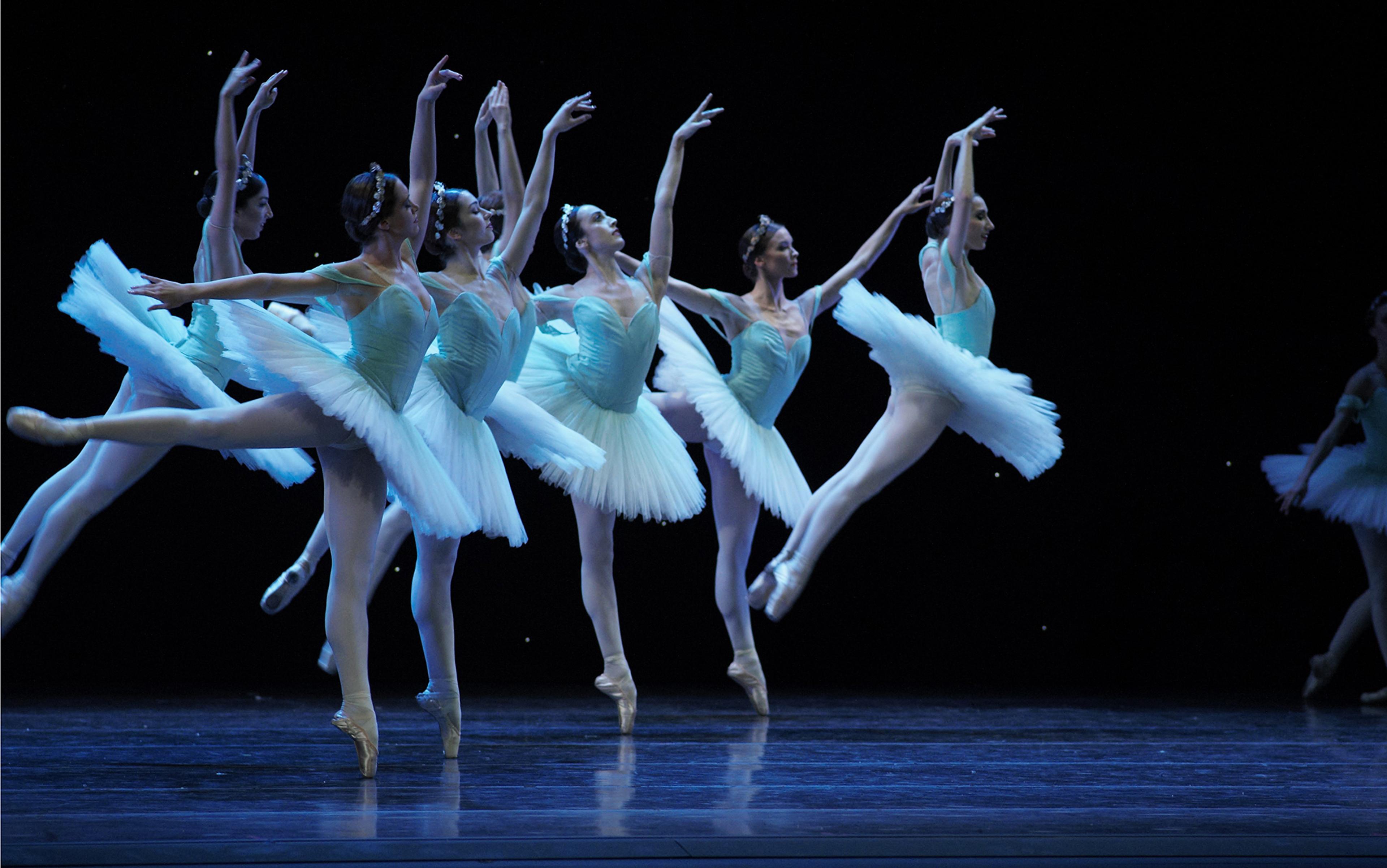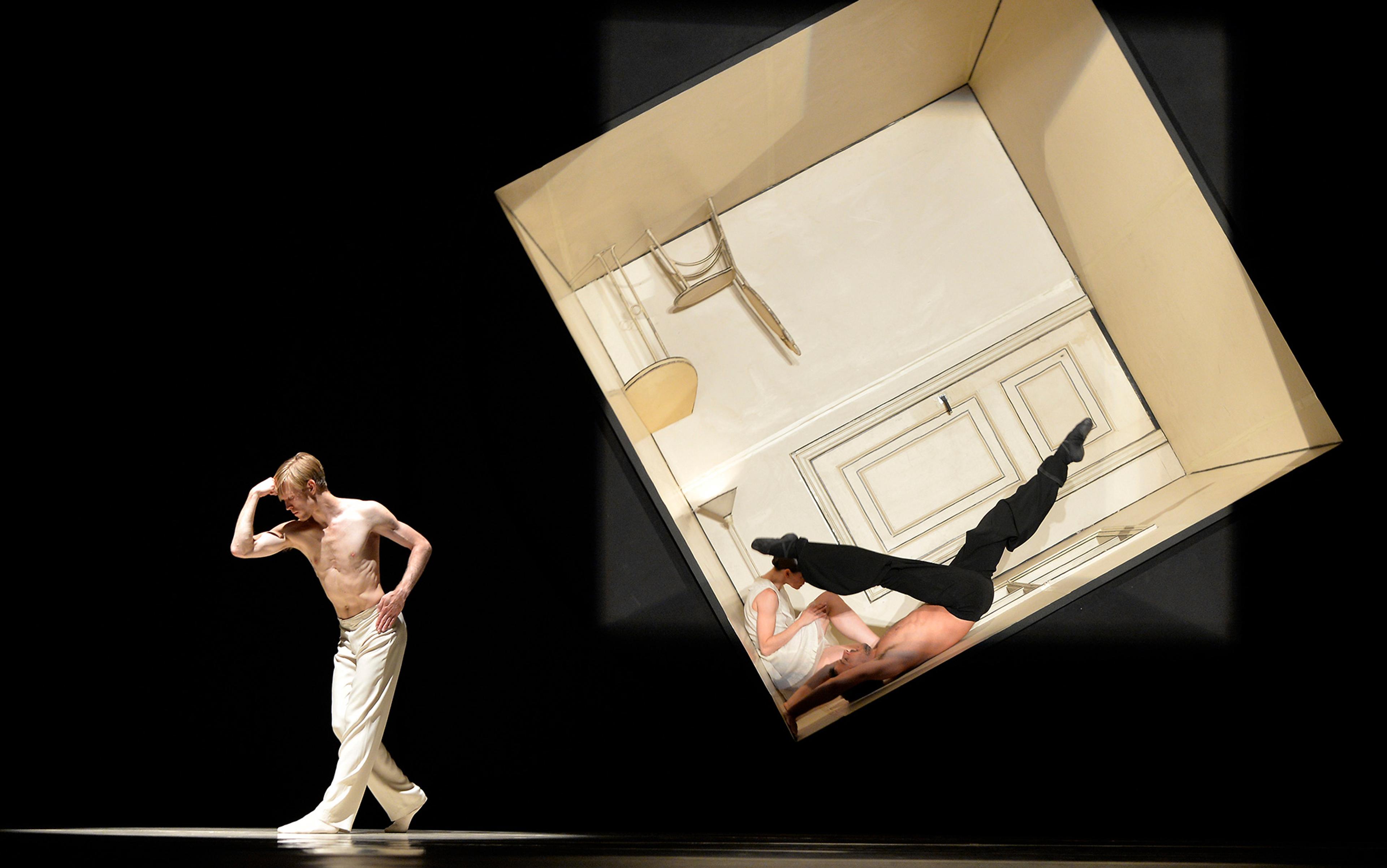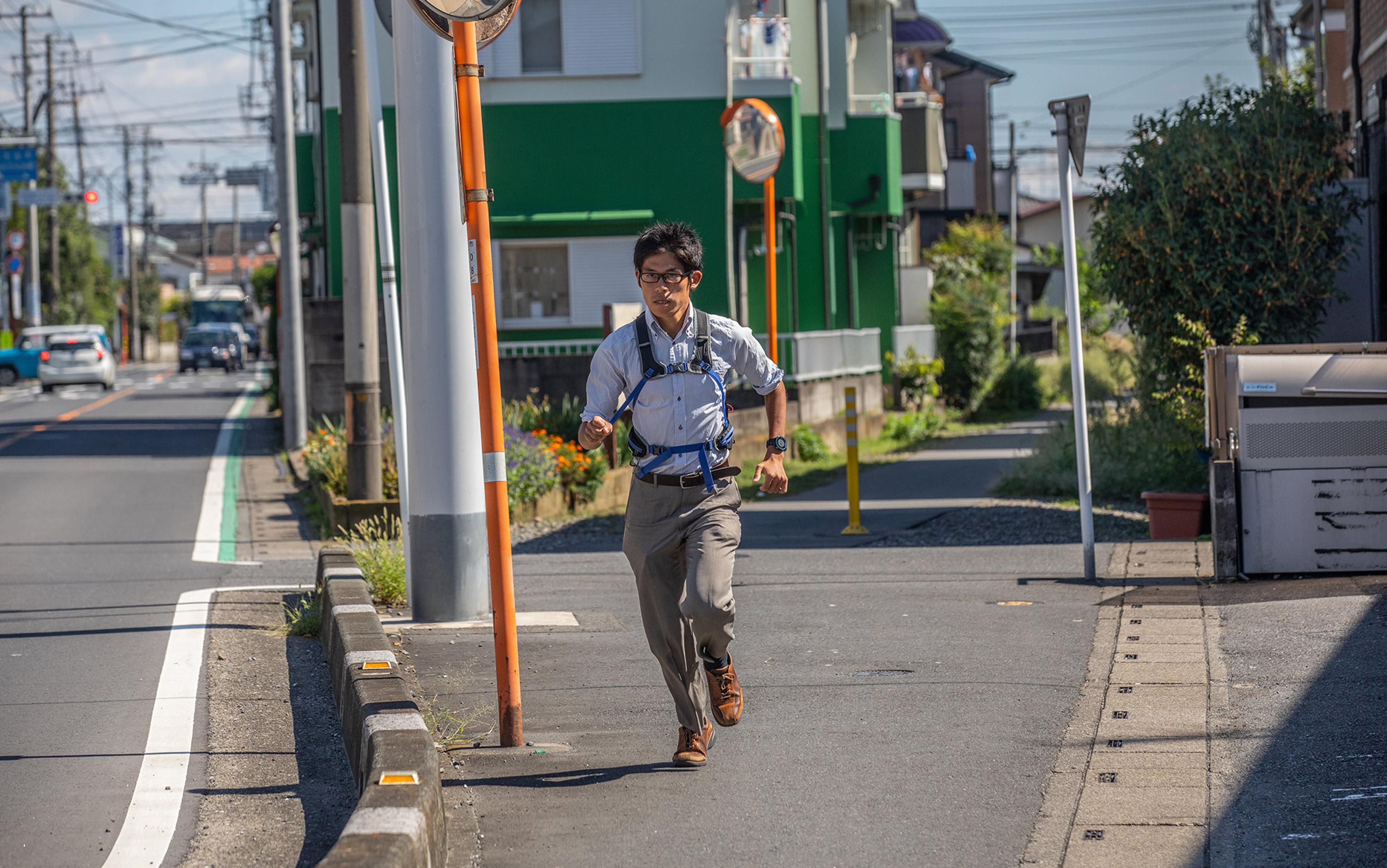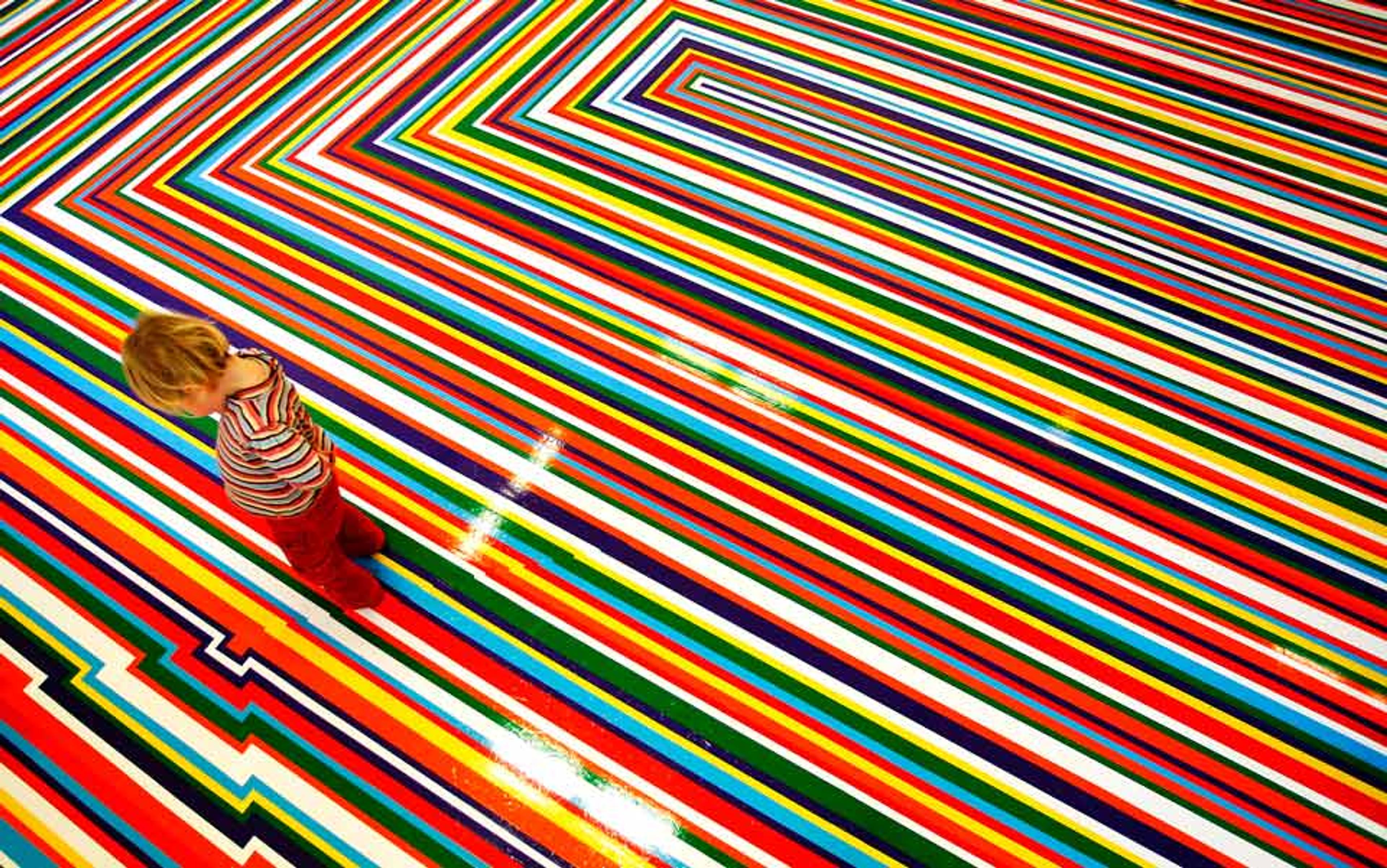When I was a student at the San Francisco Ballet School, I loved watching the advanced dancers in the class before mine. Their soaring leaps, their whirlwind turns, their command over everything from the sweep of their arms to the delicate placement of their heels – so easy did they make it all seem that I sometimes wondered if these beauteous creatures were made, not out of flesh and blood, but from dance itself.
I was therefore surprised one day to come upon a member of the class, facing the barre, working diligently on her battement tendus. A tendu is one of the first exercises you learn as a child taking ballet. It’s simple: starting from a standing position, you move one leg out to the side, point the foot on the floor, then bring it back to your starting position. Why did this supernal being need to practise such an easy step? What could possibly be improved?
Years later I realised that the answer to this question is: everything. There can be more articulation of the toes; rotation can be made more extreme; even that ineffable quality of artistry can be developed. It’s often thought that the greater your prowess, the easier your performance becomes. However, as I progressed upward through the ranks of the ballet world, I saw that this wasn’t the case. Rather, as my dancing improved, I developed both higher standards for what counts as excellence and an enhanced ability to evaluate my technique. What was once facile became difficult; what was once flawless revealed myriad imperfections; and, in certain instances, what was once enjoyable turned into a nightmarish trial.
That under the appearance of grace lies an abundance of grit is a hard-won truth running counter to the popular concept of ‘flow’: the seductive idea that when it’s time to perform – be it on stage or green, in the operating theatre or around the boardroom table – the true virtuoso leaves all striving behind. On this model of expertise, there is no intervention of conscious control, let alone doubt or indecision. Performance simply occurs, one movement after the other, with the inevitability of water running downstream. There is no need to search for ideas, because the ideas find you; there is no need to try, instead you just do.
One of the high priests of contemporary flow-speak is the writer Malcolm Gladwell. In a piece in The New Yorker in 2000, he describes how the tennis superstar Jana Novotná ‘choked’ during a match at Wimbledon in 1993, supposedly after she started thinking too much about her performance:
She lost her fluidity, her touch. She double-faulted on her serves and mis-hit her overheads, the shots that demand the greatest sensitivity in force and timing. She seemed like a different person – playing with the slow, cautious deliberation of a beginner – because, in a sense, she was a beginner again; she was relying on a learning system that she hadn’t used to hit serves and overhead forehands and volleys since she was first taught tennis, as a child.
But missing from Gladwell’s account is Novotná’s own perspective on what caused her to crumble; without that, it is difficult to know if overthinking was the culprit. What might have been going on in her mind instead? Perhaps some comments by the former Major League Baseball pitcher Steve Blass provide a clue. In the middle of a stunning career, he inexplicably lost his ability to control his pitches. As Blass writes in his memoir, A Pirate for Life (2012):
Before my control problem, I had the ability to just concentrate on the immediate task at hand, which is a wonderful thing for an athlete. I could block out family, world hunger, or anything that was going on, because of that focus. That focus all went away, and everything was occurring in my mind. I was like an antenna.
Although Blass claims that his loss of skill is mysterious, this description makes it sound as if the problem wasn’t that he was thinking too much about his actions, but rather that he was unable to think about them enough. Novotná, though her problem was thankfully short-lived, might have found herself similarly unable to focus on what mattered.
What’s more, in contrast to Gladwell’s account, it’s not clear that young beginners do proceed with cautious deliberation. In their 1987 study of children’s writing skills, the education researchers Carl Bereiter and Marlene Scardamalia found that ‘the paragons of effortless performance were fifth-graders who, given a simple topic, would start writing in seconds and would produce copy as fast as their little fingers could move the pencil.’
Those fifth-graders are in flow. The young tennis player’s game is fun, and the child’s tendu is easy. It’s the experts’ technique that becomes difficult; not to the outside world, but to themselves. Just as in Plato’s dialogue the Apology, where Socrates is wise because he knows he is ignorant, it’s the capacity to recognise where there’s room for improvement that leads us to the highest levels of human achievement. In other words, the idea that expert actions are in a placid state of flow – a state in which things seem to fall into place on their own – is a myth.
After my training in San Francisco, I went on to have a brief but varied career as a dancer, eventually settling down at Oregon Ballet under the direction of James Canfield. I left ballet because, among other things, I was ready to stop being judged by how I looked (something that persists in academia, but at least with less stringent standards). Perhaps this distaste for being judged by appearances helps explain my interest in flow – and why I occasionally refer to ‘flow’ as ‘that four-letter word’.
In truth, however, when the term is understood as originally conceived, I think it’s highly desirable. The concept of flow was developed by the Hungarian-born psychologist Mihaly Csikszentmihalyi and was intended to capture the way people feel when they are fully engaged in what they are doing. Activities done while in flow are ‘autotelic’, according to Csikszentmihalyi – that is, one does them not because of what they might lead to (or at least not entirely because of that) but because they are rewarding in and of themselves. In Flow: The Psychology of Optimal Experience (1990), he describes it like this:
In normal life, we keep interrupting what we do with doubts and questions. ‘Why am I doing this? Should I perhaps be doing something else?’ Repeatedly we question the necessity of our actions, and evaluate critically the reasons for carrying them out. But in flow there is no need to reflect, because the action carries us forward as if by magic.
Csikszentmihalyi’s research suggests that flow is conducive to optimal experience. But it doesn’t tell us anything about whether it is conducive to optimal performance. So look for flow when you want to feel better, but not necessarily when you want to do better. This doesn’t mean that performing is always unpleasant; in my experience, it’s not quite as bad as the comedian Steve Martin makes out in his memoir Born Standing Up (2007), where he writes: ‘Enjoyment while performing … would have been an indulgent loss of focus that comedy cannot afford.’ Still, enjoyable performances are not necessarily the best performances. Relinquishing the quest for pleasure is sometimes the only way to embark on that never-ending path to perfection.
What stands in the way of untrammelled joy is self-evaluation. A large body of research by the psychologist K Anders Ericsson indicates that critical self-reflection is essential to the best training regimens. In contrast to mindlessly doing an action over and over again, Ericsson advocates deliberate practice – working on the most difficult aspects of a task, followed by an analysis of one’s own successes and failures. Deliberate practice, he and his colleagues say in a 1993 article, is ‘very high on relevance for performance, high on effort, and comparatively low on inherent enjoyment’.
Flaubert spent a morning inserting a comma, and an afternoon removing it. If it’s what it took to write Madame Bovary, it was worth it
Ericsson, however, doesn’t take things far enough, since he assumes that the analysis lets up once the lights are on. In my dance career, I’ve never found this to be the case. Certainly, one cannot stop the music, ask the audience for their forgiveness and try again. But one does at times notice mistakes, making mental notes about what works and what doesn’t. In some ways, writing is similar. ‘Why am I putting this idea here?’ ‘Might it not be better in an earlier section of the piece?’ ‘Should I be giving a definition here rather than simply an illustration?’ Such questions can help craft a compelling and coherent piece of text, though they can be tiresome and even painful. This is why, unlike being in flow, writing is not particularly autotelic. One writes not because writing is rewarding, but rather because one feels compelled, or one has something one needs to say, or even, because it will feel so good when it’s done. As Billy Joel told The New York Times in 2013: ‘I love having written; but I hate writing.’
Of course, not all self-criticism is productive. My unrelenting worries about why my physique wasn’t suitable for ballet would have been better shelved. However, other critical thoughts worked to my advantage: ‘I don’t think I positioned my left shoulder correctly in the lift, but I can readjust; I think the music is calling for a grander flourish than I have been giving it; I could pause longer here or keep moving,’ and so on. This type of mindset is the opposite of savouring whatever gets washed up to shore. The 19th-century French novelist Gustave Flaubert purportedly said he once spent the entire morning inserting a comma, and the entire afternoon removing it. Strictly speaking, that might be unproductive. Then again, if it’s what it took to write Madame Bovary (1856), it was worth it.
Inbal Segev, the Israeli-born cello player, once told me that she was trained by her teacher – himself a student of the great Pablo Casals – to avoid getting lost in the music. Similarly, dancers need to avoid getting lost in the dance. One of my ballet teachers, Graciela Kozak, who danced for many years with the Bat-Dor and Bat-Sheva companies in Israel, tells her students to ‘be like a driver at the wheel’. Kozak believes that in some of the best displays of artistry, the deliberating mind doesn’t meld into the movement, but is experienced as the master in control. The Irish poet William Butler Yeats once wrote: ‘How can we know the dancer from the dance?’ Perhaps the audience can’t tell the dancer from the dance, but the dancer knows. I wonder if Yeats ever tried a pirouette?
Along with an enjoyable loss of self, the concept of flow implies a high degree of effortlessness; it implies a view championed by Edward Slingerland, an Asian Studies scholar at the University of British Columbia, according to which highly skilled action doesn’t involve trying. True ease is ‘unfakeable’, he tells us in Trying Not to Try: The Art and Science of Spontaneity (2014). However, as a ballet dancer, faking effortlessness was something I got paid to do. I didn’t try not to try, which, as Slingerland admits, is rather paradoxical. But by attempting to take the tension out of my shoulders when performing a sequence of small jumps, or to relax my facial muscles when holding a balance, or to make one movement seamlessly connect to another, I was trying to appear as if I were not trying. As a dancer, I learned that ballet is not effortless: those ethereal nymphs in Les Sylphides who seem to simply levitate are actually jumping their wings off.
Musicians’ effortlessness can also be misleading. The violinist Arnold Steinhardt, in Indivisible by Four: A String Quartet in Pursuit of Harmony (1998), writes that, after such a long time, one might have expected that the music ‘would have settled comfortably into the muscles, tendons, even the synapses of the brain, and play itself’. But it is not like that for Steinhardt. Even when he’s practised innumerable times, the playing doesn’t happen on its own. That’s not to say that he can’t ‘slip into the music’s spiritual realm’, as he puts it. But this realm is also his ‘work area’, in which the members of his quartet ‘expend a significant amount of energy slaving over [their] individual instruments’. However sublime the quartet’s performances, they are not handed down from above.
We value cool because we assume that those who act effortlessly have plenty of resources for when bigger challenges arise
For some artists, there isn’t even a simulacrum of ease. The modern dance choreography of the late Pina Bausch, for example, is aesthetically distinctive for its capacity to express frustration, alienation, brutality, and pain, rather than effortlessness. Even in the ballet world, one sometimes wants to see dancers work. I remember Istvan Rabovsky, the former director of a small company I danced with in New York City, admonishing me for a making my battement frappés look too easy. He wanted to see the effort. Zadie Smith, in her latest novel Swing Time (2016), describes the pop-star character Aimee as someone who summons joy out of struggle: ‘for no move of hers flowed instinctively or naturally from the next, each “step” was clearly visible, choreographed, and yet as she sweated away at their execution, the hard work itself felt erotic, it was like witnessing a woman cross the line at the end of a marathon, or working towards her own orgasm’.
For the most part, however, the effort of ballet remains cloaked in a guise of gracious ease. This makes ballet a stylised version of a pervasive phenomenon: the cult of cool, which prizes the ability to perform difficult actions with insouciance. The Italian Renaissance author and diplomat Baldassare Castiglione was an early champion of cool, or what he thought of as studied carelessness, calling it ‘sprezzatura’. And his Book of the Courtier (1528) delineates in exquisite detail how to ‘practise in all things a certain nonchalance which conceals all artistry and makes whatever one says or does seem uncontrived and effortless’. As Castiglione understood, we value cool because we assume that those who act effortlessly must have plenty of resources in reserve for when bigger challenges arise. They exhibit a superfluity of fitness. Creating this appearance of ease is so valuable, Castiglione thought, that one should devote considerable effort to making it happen.
Castiglione’s philosophy of sprezzatura inspired a multitude of cultural representations. Many Renaissance artists depicted individuals in utter repose, such as Raphael’s portrait of Pope Leo X, which reveals a man in tranquil thought, with hands so smooth and delicate that they appear never to have wielded a tool. Later came the ‘panache’ of Cyrano de Bergerac, the filmography of Humphrey Bogart, the detached suavity of the hipster. And when one considers how many times the media criticised Hillary Clinton for sounding ‘wooden’, ‘unspontaneous’, and ‘overly rehearsed’ during her presidential campaign, it’s clear that Castiglione’s courtly advice is no less applicable today than it was during the 1500s.
While Castiglione counsels striving for success but never letting it show, advocates of the fashionable account of flow urge you to let up on the striving altogether. It’s only the former that has a chance of getting you where you want to be. Indeed, Castiglione’s precepts notwithstanding, I might even go so far as to say that it’s the striving, not the apparent slickness, that matters most.
Why is the idea that optimal performance occurs in a state of flow so widespread, if it’s wrong? We’ve come across one reason: as Castiglione and every ballet dancer knows, thought and effort can be externally invisible. We watch the NBA basketball player Stephen Curry’s 30-foot shots arc through the air and assume that his actions are second nature. But it is a mistake to infer ease from a lack of apparent effort. Aristotle wrote in the Physics: ‘It is absurd to suppose that purpose is not present because we do not observe the agent deliberating.’ His goal was to illustrate the existence of nature’s aims in the absence of consciousness. However, we can apply Aristotle’s wisdom to expert athletes and dancers who provide no outward indication of painstaking thought. As is often the case, looks don’t tell the whole story.
Another motive for flow’s appeal is that people tend to jump from their experience of well-worn, everyday actions to conclusions about activities in highly skilled domains, such as those of professional athletes and dancers. Yet not only do these individuals train thoughtfully and continually – when was the last time you thought about how to improve the way you tie your shoes? – their motivation is completely different. Sending a text might matter to you more than increasing your walking speed, so you let the legs move on autopilot while you tap at your smartphone screen. In expert-level skills, however, it is the task at hand that is primary. Yes, you could send a Snapchat from your bike during the Tour de France. But why would you, when winning matters as much as life itself?
The late philosopher Hubert Dreyfus at the University of California, Berkeley, who did extensive research into the phenomenology of skill, rests his theory of expertise on a blurring of the distinction between the everyday and the exceptional. In line with the popular conception of flow, Dreyfus maintains that, at the pinnacle of achievement, one’s actions are ‘nonminded’. As he argues in a 2004 paper co-authored with his brother, the computer scientist Stuart Dreyfus, when you perform a highly practised skill, whether quotidian or professional: ‘What must be done, simply is done.’ The pair was once hired to study expertise in the air force. Neither had ever piloted a plane, so instead they reflected on their experience of driving, and generalised from there. But unless you are a race-car driver, driving is typically a workaday activity; it isn’t something you put your heart and soul into. It might be a life-or-death matter, but unlike the way that air force pilots approach their tasks, we don’t treat it as such and would rather schmooze with the person in the passenger seat than give it our all. Moreover, apart from an initial learning period, it’s rarely something that we actively train in order to improve. Driving was not Hubert Dreyfus’s life-work. However, he was an amazing philosopher; why didn’t he start there?
Perhaps flow draws us in because we generally dislike hard work. Numerous self-help books turn on this tendency, suggesting that instead of buckling down to a lifetime of toil, you can reach great heights by simply letting go of the thought, the effort, the trying. But I suspect the popularity of these books springs from the same source as the vogue for fad diets that advocate eating as much as you want as long as you don’t touch carbs, gluten, animal products before noon, or anything white. It’s not that they work, but they are easy to follow.
A lesson one learns from ballet and philosophy is that one can strive for perfection, while learning to settle for less
Flow sounds appealing, and it seems to frequently coincide with some of our most pleasurable pinnacles of human experience, but it doesn’t necessarily translate into optimal performance. In great athletes, performing artists, writers, chess-players, doctors, nurses, air-force pilots and others, beneath the surface of effortless flow is unrelenting determination. And if developing one’s potential is key to a meaningful life – developing what Immanuel Kant speaks of in the Groundwork for the Metaphysics of Morals as our duty to cultivate our ‘predispositions to greater perfection’ – then flow, while bringing momentary happiness, might impede the attainment of that loftier value.
In All Things Shining: Reading the Western Classics to Find Meaning in a Secular Age (2011), Dreyfus and the Harvard philosopher Sean Dorrance Kelly speculate that perhaps the writer David Foster Wallace fell into despair because his ruminations over his work made him incapable of experiencing happiness and gratitude – feelings, as they see it, that arise from standing back and letting things flow. I do not know whether Wallace’s tendency to incessantly analyse his writing stripped away his joy in life. Yet I imagine that far from interfering with his ability to find the right word, the right idea, the right mood for his characters, it was conducive to it.
It’s often said that ‘the great is the enemy of the good’. However, a lesson one learns by heart from ballet and philosophy is that one can still strive for perfection, while learning to settle for less. Both endeavours aim at ideals that are, for the most part, unattainable. Ballet dancers try to supersede anatomical limitations, leading to bloody toes and broken bones. Philosophers doggedly search for solutions to problems that can never be fully solved. Yes, great is the enemy of good; but it is also true that complacency – which is what flow really leads to – is the ally of stagnation.






